Influence of Graphene Oxide Concentration and Ultrasonication Energy on Fracture Behavior of Nano-Reinforced Cement Pastes
Abstract
:1. Introduction
2. Materials and Methods
2.1. Materials
2.2. GO Dispersion Analyses
2.3. Mix Proportions and Specimen Preparation
3. Experimental Program
3.1. Fracture Behavior
3.2. Compressive Strength and Young’s Modulus
3.3. Mercury Instrusion Porosimetry (MIP)
3.4. Stereomicroscope
3.5. SEM
4. Results
4.1. Porosity of Cement Matrix
4.2. Compressive Strength and Young’s Modulus
4.3. Fracture Behavior
5. Conclusions
- Proper ultrasonication should adjust the size of the GO to match the pore sizes of the original paste, rather than making the GO as small as possible. If sonication produces a particle size that is too small for the pore size of the matrix intended for reinforcement, the effect of the GO on porosity will be negligible.
- The P–0.03–663 exhibits the highest fracture energy at 7.8% compared to non-reinforced paste. This is primarily attributed to the optimal combination of capillary and micropores, resulting in elevated tensile strength and consequently higher fracture energy.
- The lowest characteristic length was observed for the P–0.045–663 fundamentally influenced by the reduced combination of capillary pores and micropores, which leads to a more brittle matrix.
- The tensile strength of the material is more influenced by the micropores than by the capillary pores; it is higher when the GO is sonicated, and the maximum value was obtained for the sample P–0.045–663.
Author Contributions
Funding
Data Availability Statement
Conflicts of Interest
References
- Jiang, C.; Fan, K.; Wu, F.; Chen, D. Experimental study on the mechanical properties and microstructure of chopped basalt fibre reinforced concrete. Mater. Des. 2014, 58, 187–193. [Google Scholar] [CrossRef]
- Van Mier, J.G.M.; Van Vliet, M.R.A. Influence of microstructure of concrete on size/scale effects in tensile fracture. Eng. Fract. Mech. 2003, 70, 2281–2306. [Google Scholar] [CrossRef]
- Ren, J.; Lai, Y. Study on the durability and failure mechanism of concrete modified with nanoparticles and polypropylene fiber under freeze-thaw cycles and sulfate attack. Cold Reg. Sci. Technol. 2021, 188, 103301. [Google Scholar] [CrossRef]
- Ríos, J.D.; Leiva, C.; Ariza, M.P.; Seitl, S.; Cifuentes, H. Analysis of the tensile fracture properties of ultra-high-strength fiber-reinforced concrete with different types of steel fibers by X-ray tomography. Mater. Des. 2019, 165, 107582. [Google Scholar] [CrossRef]
- Ríos, J.D.; Cifuentes, H.; Leiva, C.; Seitl, S. Analysis of the mechanical and fracture behavior of heated ultra-high-performance fiber-reinforced concrete by X-ray computed tomography. Cem. Concr. Res. 2019, 119, 77–88. [Google Scholar] [CrossRef]
- Cong, X.; Qiu, T.; Xu, J.; Liu, X.; Wang, L.; Wang, Y.; Chen, C.; Zhao, L.; Xing, C.; Tan, Y. Study on the effectiveness of fibre reinforcement on the engineering performance of foamed concrete. Case Stud. Constr. Mater. 2022, 16, e01015. [Google Scholar] [CrossRef]
- Zhang, B.; Feng, Y.; Xie, J.; He, J.; Zhang, Y.; Cai, C.; Huang, D.; Li, L. Effects of fibres on ultra-lightweight high strength concrete: Dynamic behaviour and microstructures. Cem. Concr. Compos. 2022, 128, 104417. [Google Scholar] [CrossRef]
- Puentes, J.; Barluenga, G.; Palomar, I. Effects of nano-components on early age cracking of self-compacting concretes. Constr. Build. Mater. 2014, 73, 89–96. [Google Scholar] [CrossRef]
- Chen, J.; Zhao, D.; Ge, H.; Wang, J. Graphene oxide-deposited carbon fiber/cement composites for electromagnetic interference shielding application. Constr. Build. Mater. 2015, 84, 66–72. [Google Scholar] [CrossRef]
- Hawreen, A.; Bogas, J.A. Creep, shrinkage and mechanical properties of concrete reinforced with different types of carbon nanotubes. Constr. Build. Mater. 2019, 198, 70–81. [Google Scholar] [CrossRef]
- Liew, K.M.; Kai, M.F.; Zhang, L.W. Carbon nanotube reinforced cementitious composites: An overview. Compos. Part A Appl. Sci. Manuf. 2016, 91, 301–323. [Google Scholar] [CrossRef]
- Wang, B.; Zhao, R. Effect of graphene nano-sheets on the chloride penetration and microstructure of the cement based composite. Constr. Build. Mater. 2018, 161, 715–722. [Google Scholar] [CrossRef]
- e Silva, R.A.; de Castro Guetti, P.; da Luz, M.S.; Rouxinol, F.; Gelamo, R.V. Enhanced properties of cement mortars with multilayer graphene nanoparticles. Constr. Build. Mater. 2017, 149, 378–385. [Google Scholar] [CrossRef]
- Li, G.; Yuan, J.B.; Zhang, Y.H.; Zhang, N.; Liew, K.M. Microstructure and mechanical performance of graphene reinforced cementitious composites. Compos. Part A Appl. Sci. Manuf. 2018, 114, 188–195. [Google Scholar] [CrossRef]
- Xu, J.; Zhang, D. Pressure-sensitive properties of emulsion modified graphene nanoplatelets/cement composites. Cem. Concr. Compos. 2017, 84, 74–82. [Google Scholar] [CrossRef]
- Han, B.; Zheng, Q.; Sun, S.; Dong, S.; Zhang, L.; Yu, X.; Ou, J. Enhancing mechanisms of multi-layer graphenes to cementitious composites. Compos. Part A Appl. Sci. Manuf. 2017, 101, 143–150. [Google Scholar] [CrossRef]
- He, H.; Shuang, E.; Lu, D.; Hu, Y.; Yan, C.; Shan, H.; He, C. Deciphering size−induced influence of carbon dots on mechanical performance of cement composites. Constr. Build. Mater. 2024, 425, 136030. [Google Scholar] [CrossRef]
- Pan, Z.; He, L.; Qiu, L.; Korayem, A.H.; Li, G.; Zhu, J.W.; Collins, F.; Li, D.; Duan, W.H.; Wang, M.C. Mechanical properties and microstructure of a graphene oxide-cement composite. Cem. Concr. Compos. 2015, 58, 140–147. [Google Scholar] [CrossRef]
- Li, X.; Habibnejad, A.; Li, C.; Liu, Y.; He, H.; Sanjayan, J.G. Incorporation of graphene oxide and silica fume into cement paste: A study of dispersion and compressive strength. Constr. Build. Mater. 2016, 123, 327–335. [Google Scholar] [CrossRef]
- Lv, S.; Ma, Y.; Qiu, C.; Sun, T.; Liu, J.; Zhou, Q. Effect of graphene oxide nanosheets of microstructure and mechanical properties of cement composites. Constr. Build. Mater. 2013, 49, 121–127. [Google Scholar] [CrossRef]
- Jing, G.; Wu, J.; Lei, T.; Wang, S.; Strokova, V.; Nelyubova, V.; Wang, M.; Ye, Z. From graphene oxide to reduced graphene oxide: Enhanced hydration and compressive strength of cement composites. Constr. Build. Mater. 2020, 248, 118699. [Google Scholar] [CrossRef]
- Chintalapudi, K.; Mohan, R.; Pannem, R. An intense review on the performance of Graphene Oxide and reduced Graphene Oxide in an admixed cement system. Constr. Build. Mater. 2020, 259, 120598. [Google Scholar] [CrossRef]
- Yan, S.; He, P.; Jia, D.; Yang, Z.; Duan, X.; Wang, S.; Zhou, Y. Effect of reduced graphene oxide content on the microstructure and mechanical properties of graphene–geopolymer nanocomposites. Ceram. Int. 2016, 42, 752–758. [Google Scholar] [CrossRef]
- Jing, G.; Ye, Z.; Wu, J.; Wang, S.; Cheng, X.; Strokova, V. Introducing reduced graphene oxide to enhance the thermal properties of cement composites. Cem. Concr. Compos. 2020, 109, 103559. [Google Scholar] [CrossRef]
- Wang, M.; Yao, H.; Wang, R.; Zheng, S. Chemically functionalized graphene oxide as the additive for cement–matrix composite with enhanced fluidity and toughness. Constr. Build. Mater. 2017, 150, 150–156. [Google Scholar] [CrossRef]
- Qian, Y.; Abdallah, M.Y.; Kawashima, S. Characterization of Cement-Based Materials Modified with Graphene-Oxide. In Nanotechnology in Construction; Springer: Berlin/Heidelberg, Germany, 2015; pp. 259–264. [Google Scholar] [CrossRef]
- Zhao, L.; Guo, X.; Liu, Y.; Ge, C.; Chen, Z.; Guo, L.; Shu, X.; Liu, J. Investigation of dispersion behavior of GO modified by different water reducing agents in cement pore solution. Carbon 2018, 127, 255–269. [Google Scholar] [CrossRef]
- Kang, D.; Seo, K.S.; Lee, H.Y.; Chung, W. Experimental study on mechanical strength of GO-cement composites. Constr. Build. Mater. 2017, 131, 303–308. [Google Scholar] [CrossRef]
- Shamsaei, E.; de Souza, F.B.; Yao, X.; Benhelal, E.; Akbari, A.; Duan, W. Graphene-based nanosheets for stronger and more durable concrete: A review. Constr. Build. Mater. 2018, 183, 642–660. [Google Scholar] [CrossRef]
- Lu, Z.; Chen, B.; Leung, C.K.Y.; Li, Z.; Sun, G. Aggregation size effect of graphene oxide on its reinforcing efficiency to cement-based materials. Cem. Concr. Compos. 2019, 100, 85–91. [Google Scholar] [CrossRef]
- Murugan, M.; Santhanam, M.; Sen Gupta, S.; Pradeep, T.; Shah, S.P. Influence of 2D rGO nanosheets on the properties of OPC paste. Cem. Concr. Compos. 2016, 70, 48–59. [Google Scholar] [CrossRef]
- Guan, X.; Yu, L.; Li, H. Experimental study on fracture mechanics of cementitious materials reinforced by graphene oxide—Silica nanocomposites. Constr. Build. Mater. 2022, 325, 126758. [Google Scholar] [CrossRef]
- Zhao, L.; Guo, X.; Song, L.; Song, Y.; Dai, G.; Liu, J. An intensive review on the role of graphene oxide in cement-based materials. Constr. Build. Mater. 2020, 241, 117939. [Google Scholar] [CrossRef]
- Li, X.; Liu, Y.M.; Li, W.G.; Li, C.Y.; Sanjayan, J.G.; Duan, W.H.; Li, Z. Effects of graphene oxide agglomerates on workability, hydration, microstructure and compressive strength of cement paste. Constr. Build. Mater. 2017, 145, 402–410. [Google Scholar] [CrossRef]
- Yang, H.; Cui, H.; Tang, W.; Li, Z.; Han, N.; Xing, F. Composites: Part A A critical review on research progress of graphene/cement based composites. Compos. Part A Appl. Sci. Manuf. 2017, 102, 273–296. [Google Scholar] [CrossRef]
- Stobinski, L.; Lesiak, B.; Malolepszy, A.; Mazurkiewicz, M.; Mierzwa, B.; Zemek, J.; Jiricek, P.; Bieloshapka, I. Graphene oxide and reduced graphene oxide studied by the XRD, TEM and electron spectroscopy methods. J. Electron. Spectrosc. Relat. Phenom. 2014, 195, 145–154. [Google Scholar] [CrossRef]
- Vallurupalli, K.; Meng, W.; Liu, J.; Khayat, K.H. Effect of graphene oxide on rheology, hydration and strength development of cement paste. Constr. Build. Mater. 2020, 265, 120311. [Google Scholar] [CrossRef]
- Du, Y.; Yang, J.; Skariah, B.; Li, L.; Li, H. Influence of hybrid graphene oxide/carbon nanotubes on the mechanical properties and microstructure of magnesium potassium phosphate cement paste. Constr. Build. Mater. 2020, 260, 120449. [Google Scholar] [CrossRef]
- Akarsh, P.K.; Marathe, S.; Bhat, A.K. Influence of graphene oxide on properties of concrete in the presence of silica fumes and M-sand. Constr. Build. Mater. 2021, 268, 121093. [Google Scholar] [CrossRef]
- Akarsh, P.K.; Shrinidhi, D.; Marathe, S.; Bhat, A.K. Graphene oxide as nano-material in developing sustainable concrete—A brief review. Mater. Today Proc. 2022, 60, 234–246. [Google Scholar] [CrossRef]
- Rajesh, V.; Narendra Kumar, B. Influence of nano-structured graphene oxide on strength and performance characteristics of high strength fiber reinforced self compacting concrete. Mater. Today Proc. 2022, 60, 694–702. [Google Scholar] [CrossRef]
- Shang, Y.; Zhang, D.; Yang, C.; Liu, Y.; Liu, Y. Effect of graphene oxide on the rheological properties of cement pastes. Constr. Build. Mater. 2015, 96, 20–28. [Google Scholar] [CrossRef]
- Wang, Q.; Cui, X.; Wang, J.; Li, S.; Lv, C.; Dong, Y. Effect of fly ash on rheological properties of graphene oxide cement paste. Constr. Build. Mater. 2017, 138, 35–44. [Google Scholar] [CrossRef]
- Long, W.J.; Li, H.D.; Fang, C.L.; Xing, F. Uniformly dispersed and re-agglomerated graphene oxide-based cement pastes: A comparison of rheological properties, mechanical properties and microstructure. Nanomaterials 2018, 8, 31. [Google Scholar] [CrossRef] [PubMed]
- Mowlaei, R.; Lin, J.; Basquiroto, F.; Souza, D.; Fouladi, A.; Habibnejad, A.; Shamsaei, E.; Duan, W. The effects of graphene oxide-silica nanohybrids on the workability, hydration, and mechanical properties of Portland cement paste. Constr. Build. Mater. 2021, 266, 121016. [Google Scholar] [CrossRef]
- Jian, S.; Zou, B.; Collins, F.; Ling, X.; Majumber, M.; Hui, W. Predicting the influence of ultrasonication energy on the reinforcing efficiency of carbon nanotubes. Carbon 2014, 77, 1–10. [Google Scholar] [CrossRef]
- Gao, Y.; Jing, H.; Zhao, Z.; Shi, X.; Li, L. Influence of ultrasonication energy on reinforcing-roles of CNTs to strengthen ITZ and corresponding anti-permeability properties of concrete. Constr. Build. Mater. 2021, 303, 124451. [Google Scholar] [CrossRef]
- Peng, H.; Ge, Y.; Cai, C.S.; Zhang, Y.; Liu, Z. Mechanical properties and microstructure of graphene oxide cement-based composites. Constr. Build. Mater. 2019, 194, 102–109. [Google Scholar] [CrossRef]
- Jing, G.; Xu, K.; Feng, H.; Wu, J.; Wang, S.; Li, Q.; Cheng, X.; Ye, Z. The non-uniform spatial dispersion of graphene oxide: A step forward to understand the inconsistent properties of cement composites. Constr. Build. Mater. 2020, 264, 120729. [Google Scholar] [CrossRef]
- Lee, A.Y.; Yang, K.; Anh, N.D.; Park, C.; Lee, S.M.; Lee, T.G.; Jeong, M.S. Raman study of D* band in graphene oxide and its correlation with reduction. Appl. Surf. Sci. 2021, 536, 147990. [Google Scholar] [CrossRef]
- Suescum-Morales, D.; Ríos, J.D.; Martínez-De La Concha, A.; Cifuentes, H.; Jiménez, J.R.; Fernández, J.M. Cement and Concrete Research Effect of moderate temperatures on compressive strength of ultra-high-performance concrete: A microstructural analysis. Cem. Concr. Res. 2021, 140, 106303. [Google Scholar] [CrossRef]
- Esquinas, A.R.; Álvarez, J.I.; Jiménez, J.R.; Fernández, J.M. Durability of selfcompacting concrete made from non-conforming fly ash from coal-fired power plants. Constr. Build. Mater. 2018, 189, 993–1006. [Google Scholar] [CrossRef]
- Bentz, D.P.; Haecker, C.J. An argument for using coarse cements in high-performance concretes. Cem. Concr. Res. 1999, 29, 615–618. [Google Scholar] [CrossRef]
- Qureshi, T.S.; Panesar, D.K. Nano reinforced cement paste composite with functionalized graphene and pristine graphene nanoplatelets. Compos. Part B 2020, 197, 108063. [Google Scholar] [CrossRef]
- Cai, Y.; Hou, P.; Cheng, X.; Du, P.; Ye, Z. The effects of nanoSiO2 on the properties of fresh and hardened cement-based materials through its dispersion with silica fume. Constr. Build. Mater. 2017, 148, 770–780. [Google Scholar] [CrossRef]
- Gao, Y.; Jing, H.W.; Chen, S.J.; Du, M.R.; Chen, W.Q.; Duan, W.H. Influence of ultrasonication on the dispersion and enhancing effect of graphene oxide–carbon nanotube hybrid nanoreinforcement in cementitious composite. Compos. Part B Eng. 2019, 164, 45–53. [Google Scholar] [CrossRef]
- Recommendation, R.D. Determination of the Fracture Energy of Mortar and Concrete by Means of Three-Point Bend Tests on Notched Beams. Mater. Struct. 1985, 18, 285–290. [Google Scholar] [CrossRef]
- Ramachandra Murthy, A.; Karihaloo, B.L.; Iyer, N.R.; Raghu Prasad, B.K. Bilinear tension softening diagrams of concrete mixes corresponding to their size−independent specific fracture energy. Constr. Build. Mater. 2013, 47, 1160–1166. [Google Scholar] [CrossRef]
- Abdalla, H.M.; Karihaloo, B.L. A method for constructing the bilinear tension softening diagram of concrete corresponding to its true fracture energy. Mag. Concr. Res. 2004, 56, 597–604. [Google Scholar] [CrossRef]
- Cifuentes, H.; Ríos, J.D.; Martínez-De La Concha, A. Analysis of the behavior of very high strength concrete subjected to thermal shock loading. Hormigón Y Acero 2022, 73, 73–79. [Google Scholar] [CrossRef]
- Martínez-de-la-Concha, A.; Ríos, J.D.; Cifuentes, H. Numerical Study of the Shear Behavior of Ultra-High-Performance Concrete Beams. Hormigón Y Acero 2023, 75, 157–162. [Google Scholar] [CrossRef]
- EN-12390-3: 2009; Testing Hardened Concrete Part 3: Compressive Strength of Test Specimens, AENOR. European Committee for Standarization (CEN): Brussels, Brussels, 2009.
- Swartz, S.E.; Shah, S.P.; Ouyang, C. Fracture Mechanics of Concrete; John Wiley & Sons: Hoboken, NJ, USA, 1995. [Google Scholar]
- Xiong, G.; Ren, Y.; Wang, C.; Zhang, Z.; Zhou, S.; Kuang, C.; Zhao, Y.; Guo, B.; Hong, S. Effect of power ultrasound assisted mixing on graphene oxide in cement paste: Dispersion, microstructure and mechanical properties. J. Build. Eng. 2023, 69, 106321. [Google Scholar] [CrossRef]
- Chacón Bonet, C.; Cifuentes Bulte, H.; Luna-Galiano, Y.; Rios, J.D.; Ariza, P.; Carlos, C.L. Exploring the impact of graphene oxide on mechanical and durability properties of mortars incorporating demolition waste: Micro and nano-pore structure effects. Mater. Construcción 2023, 73, e327. [Google Scholar] [CrossRef]
- Hong, X.; Lee, J.C.; Ng, J.L.; Md Yusof, Z.; He, Q.; Li, Q. Effect of Graphene Oxide on the Mechanical Properties and Durability of High-Strength Lightweight Concrete Containing Shale Ceramsite. Materials 2023, 16, 2756. [Google Scholar] [CrossRef] [PubMed]
- Ruiz Martinez, J.D.; Cifuentes, H.; Rios, J.D.; Ariza, P.; Leiva, C. Development of Mortars That Use Recycled Aggregates from a Sodium Silicate Process and the Influence of Graphene Oxide as a Nano-Addition. Materials 2023, 16, 7167. [Google Scholar] [CrossRef] [PubMed]
- Kendall, K.; Howard, A.J.; Birchall, J.D.; Pratt, P.L.; Proctor, B.A.; Jefferis, S.A.; Hirsch, P.B.; Birchall, J.D.; Double, D.D.; Kelly, A.; et al. The relation between porosity, microstructure and strength, and the approach to advanced cement-based materials. Philos. Trans. R. Soc. London. Ser. A Math. Phys. Sci. 1983, 310, 139–153. [Google Scholar] [CrossRef]
- Chen, X.; Wu, S.; Zhou, J. Influence of porosity on compressive and tensile strength of cement mortar. Constr. Build. Mater. 2013, 40, 869–874. [Google Scholar] [CrossRef]
- Fang, B.; Qian, Z.; Song, Y.; Diao, X.; Shi, T.; Cai, X.; Wang, L. Evaluation of early crack resistance performance of concrete mixed with ternary minerals using temperature stress testing machine (TSTM). J. Clean. Prod. 2024, 465, 142780. [Google Scholar] [CrossRef]
- Scrivener, K.L.; Crumbie, A.K.; Laugesen, P. The Interfacial Transition Zone (ITZ) Between Cement Paste and Aggregate in Concrete. Interface Sci. 2004, 12, 411–421. [Google Scholar] [CrossRef]
- Hillerborg, A.; Modéer, M.; Peterson, P.E. Analysis of crack formation and crack growth by means of fracture mechanics and finite elements. Cem. Concr. Res. 1976, 6, 773–781. [Google Scholar] [CrossRef]
- Bazant, Z.P. Concrete fracture models: Testing and practice. Eng. Fract. Mech. 2002, 69, 165–205. [Google Scholar] [CrossRef]
- Alyhya, W.S.; Dhaheer, M.S.A.; Karihaloo, B.L. Influence of mix composition and strength on the fracture properties of self−compacting concrete. Constr. Build. Mater. 2016, 110, 312–322. [Google Scholar] [CrossRef]
- Qureshi, T.S.; Panesar, D. Impact of graphene oxide and highly reduced graphene oxide on cement based composites. Constr. Build. Mater. 2019, 206, 71–83. [Google Scholar] [CrossRef]
- Xiao, J.; Lv, Z.; Duan, Z.; Zhang, C. Pore structure characteristics, modulation and its effect on concrete properties: A review. Constr. Build. Mater. 2023, 397, 132430. [Google Scholar] [CrossRef]
- Cifuentes, H.; Karihaloo, B.H. Determination of size−independent specific fracture energy of normal− and high−strength self−compacting concrete from wedge splitting tests. Constr. Build. Mater. 2013, 48, 548–553. [Google Scholar] [CrossRef]
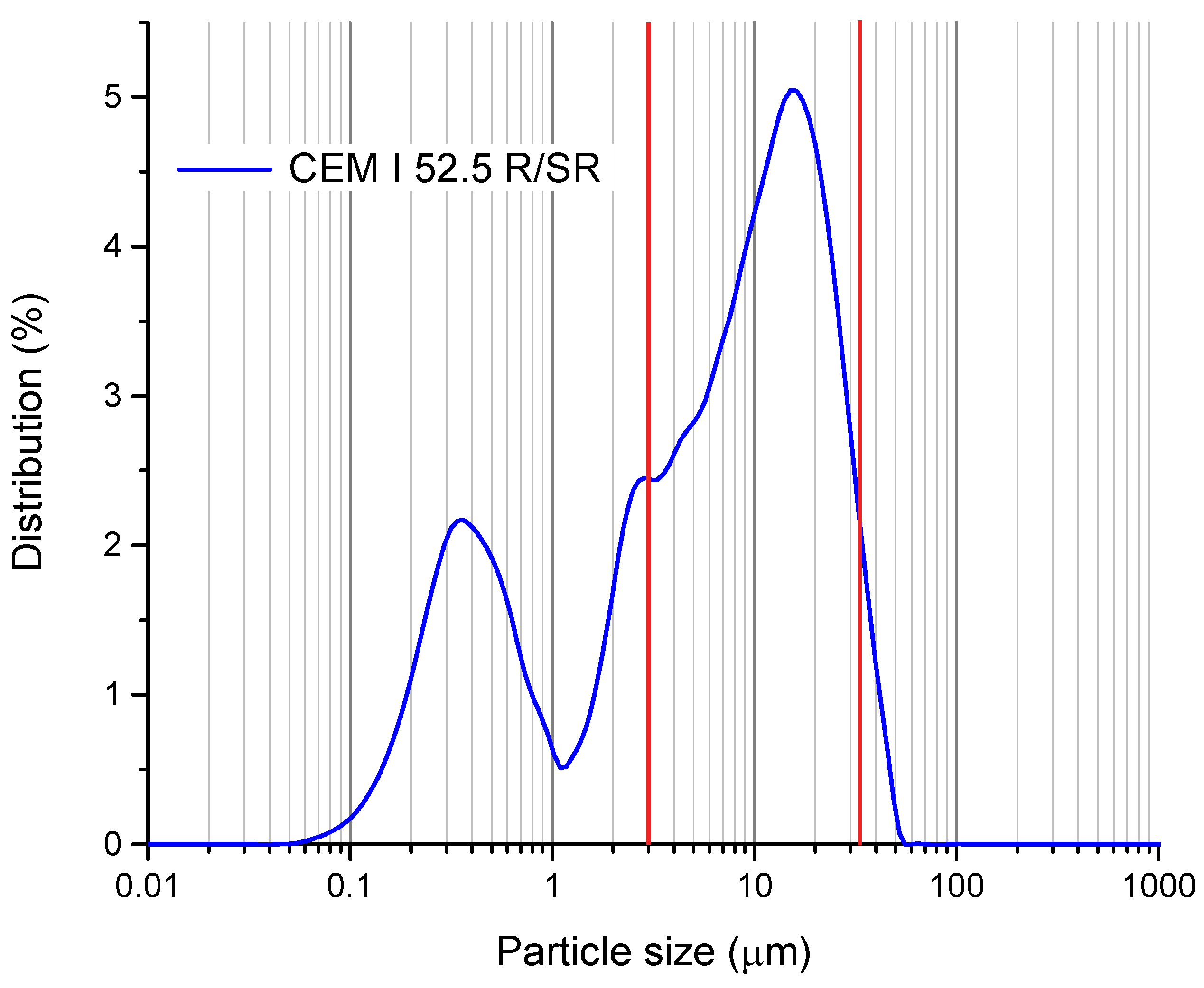
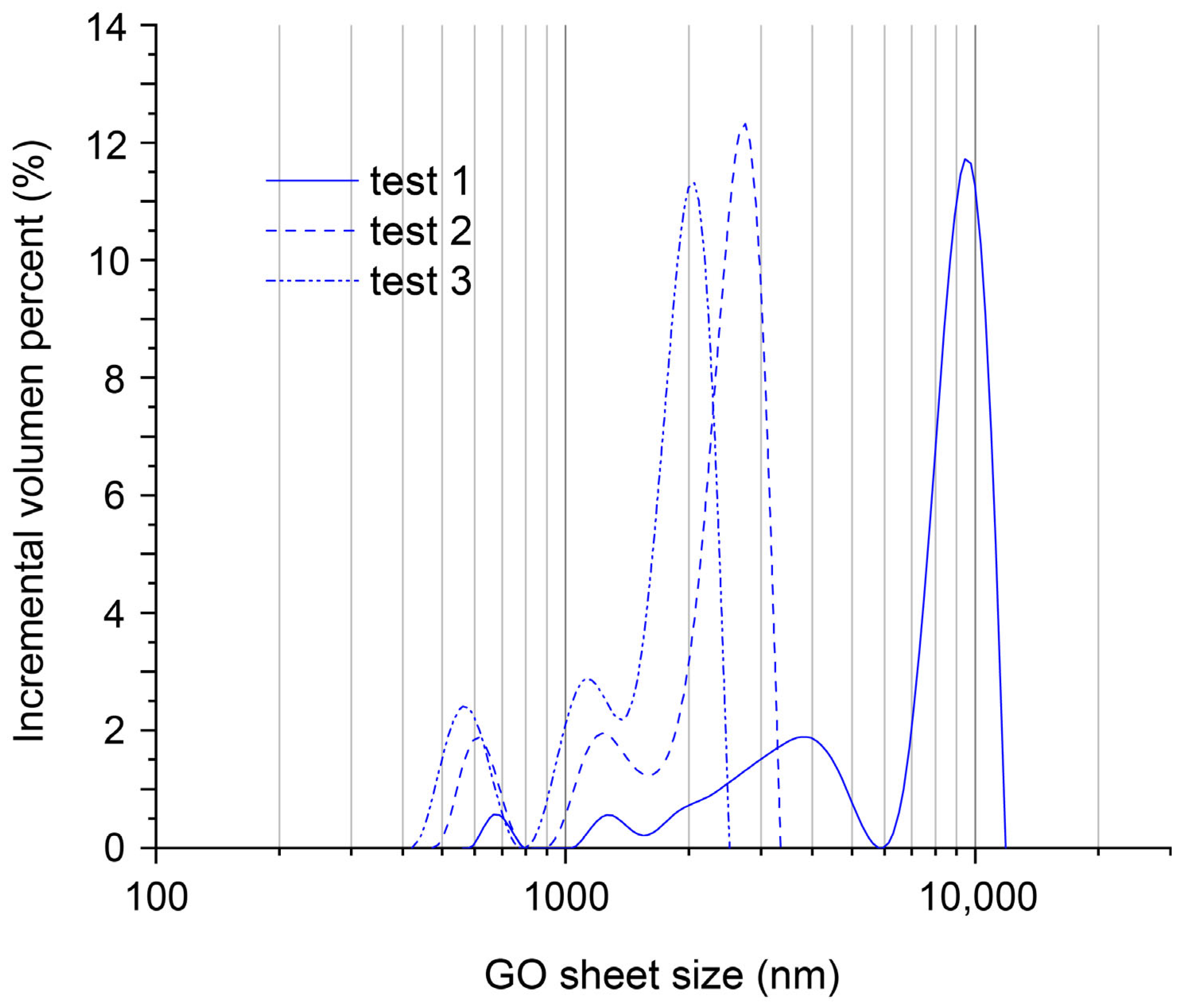
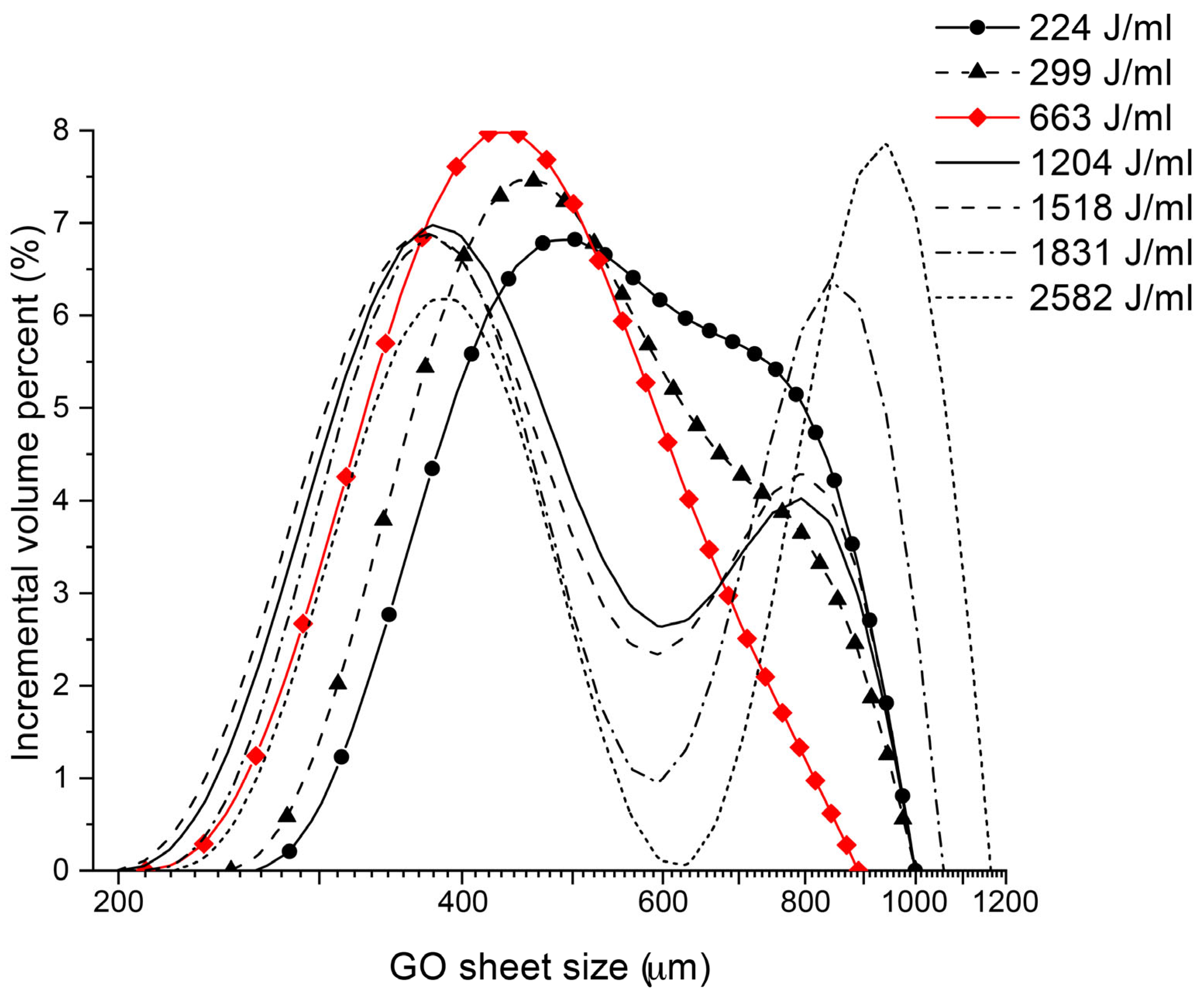

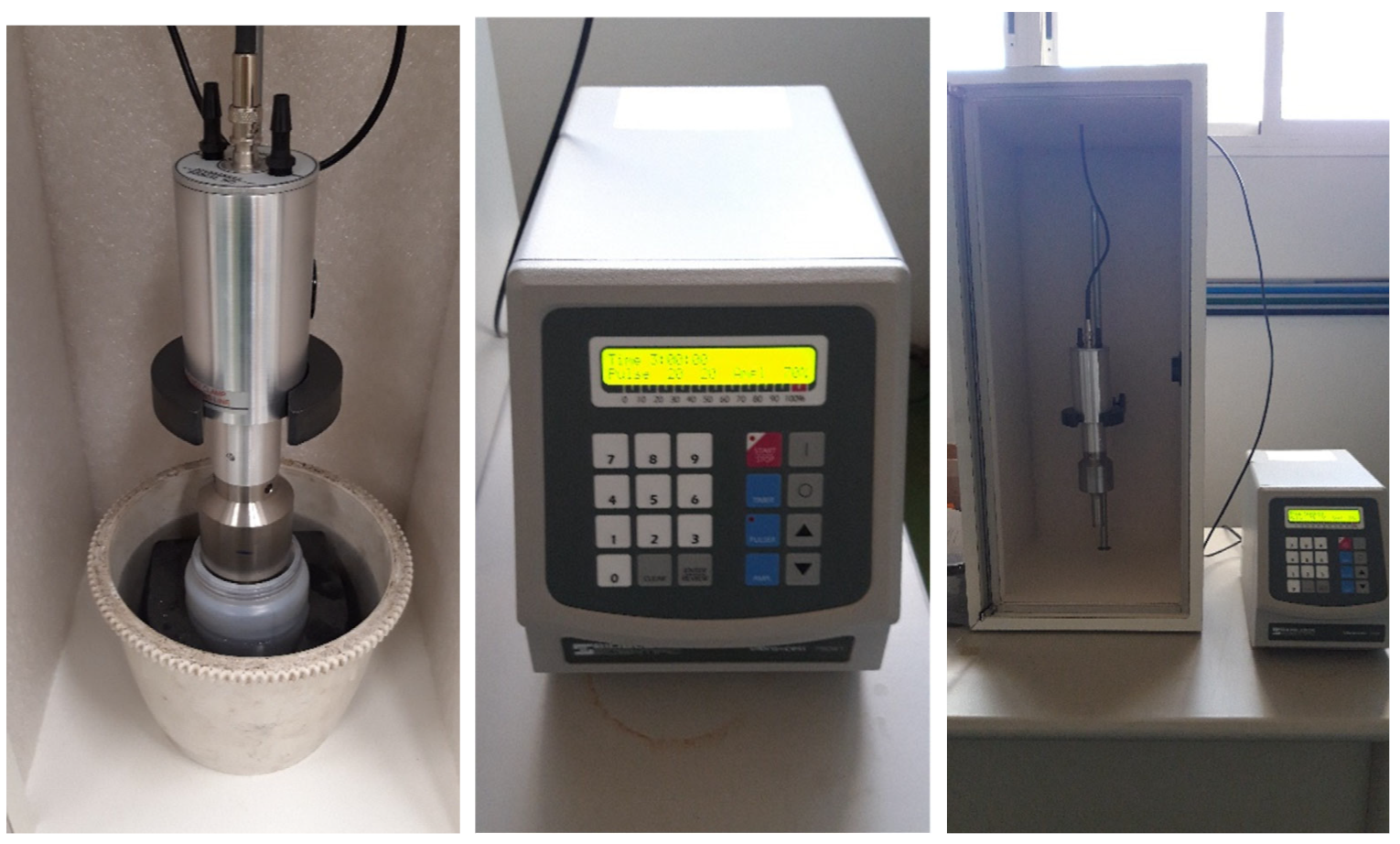
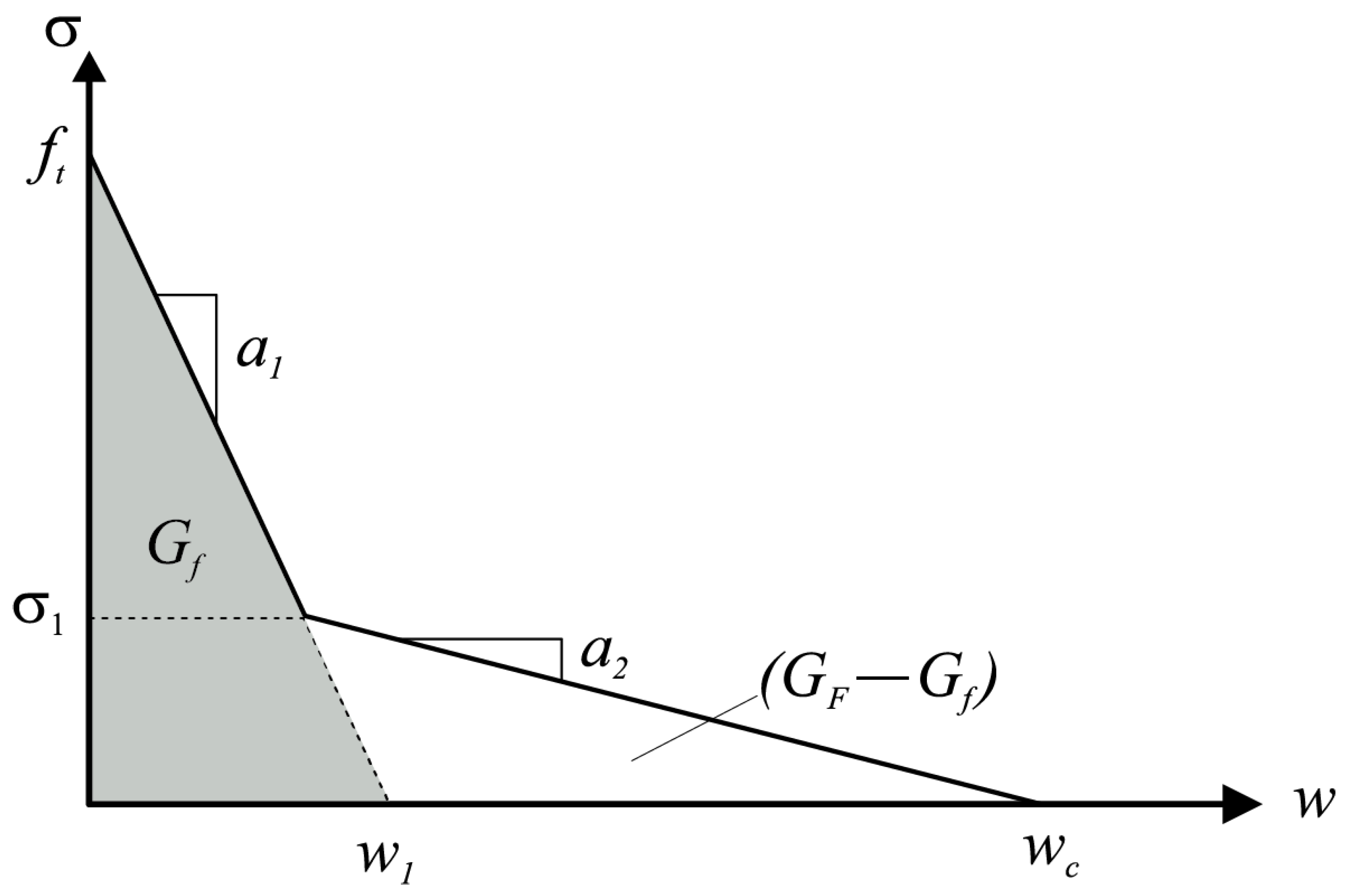

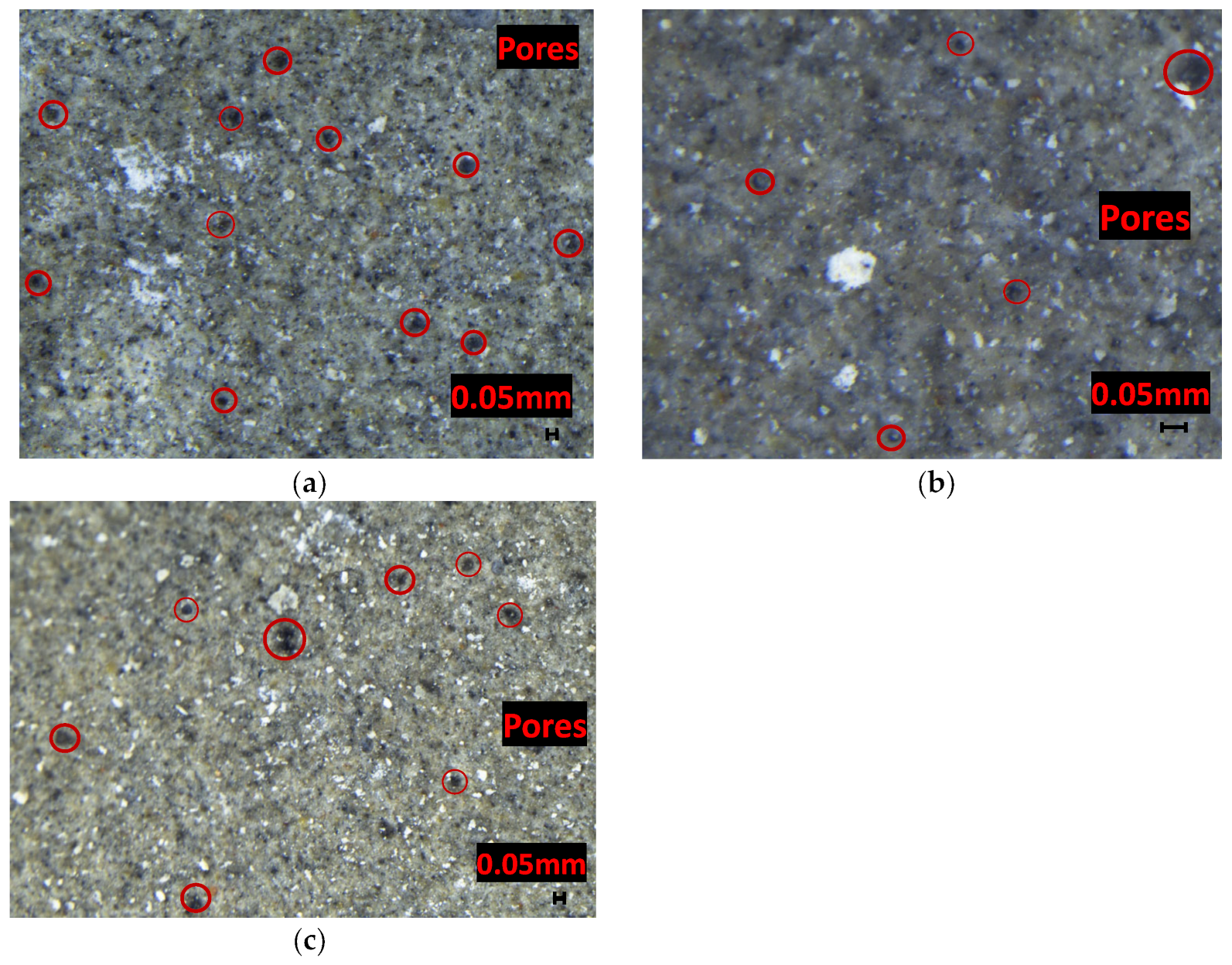
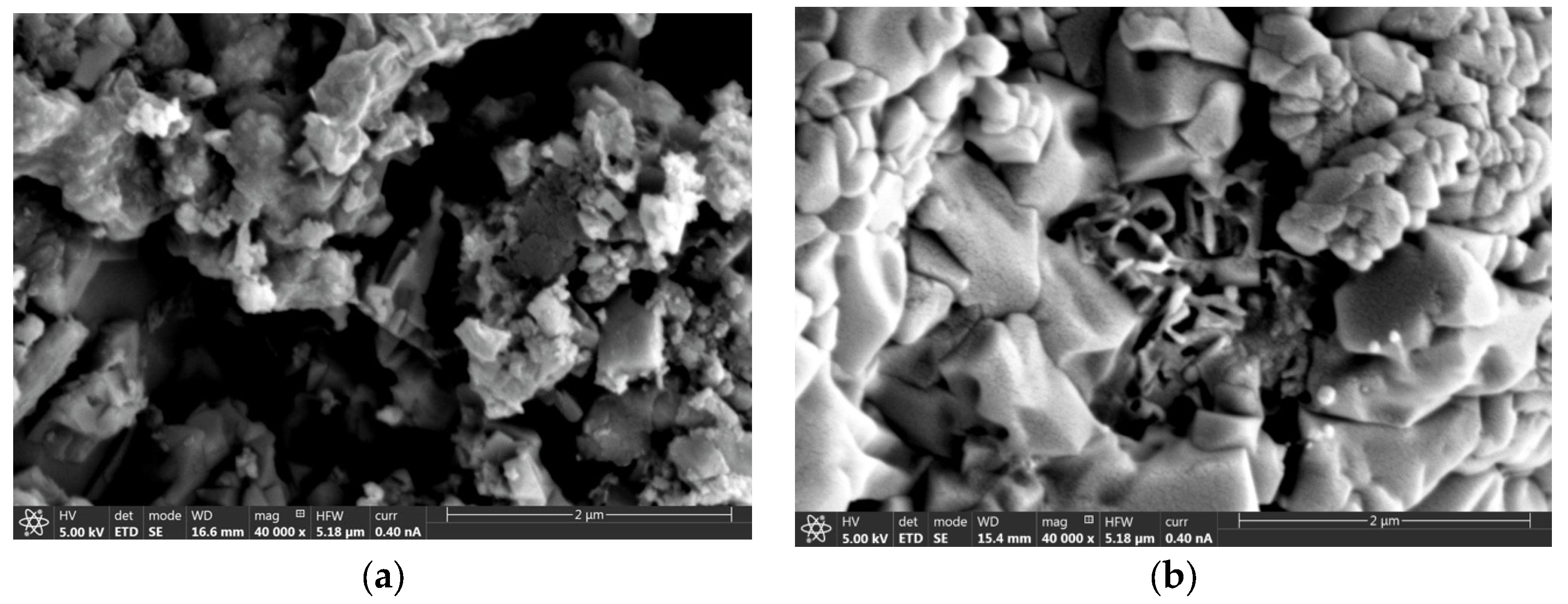
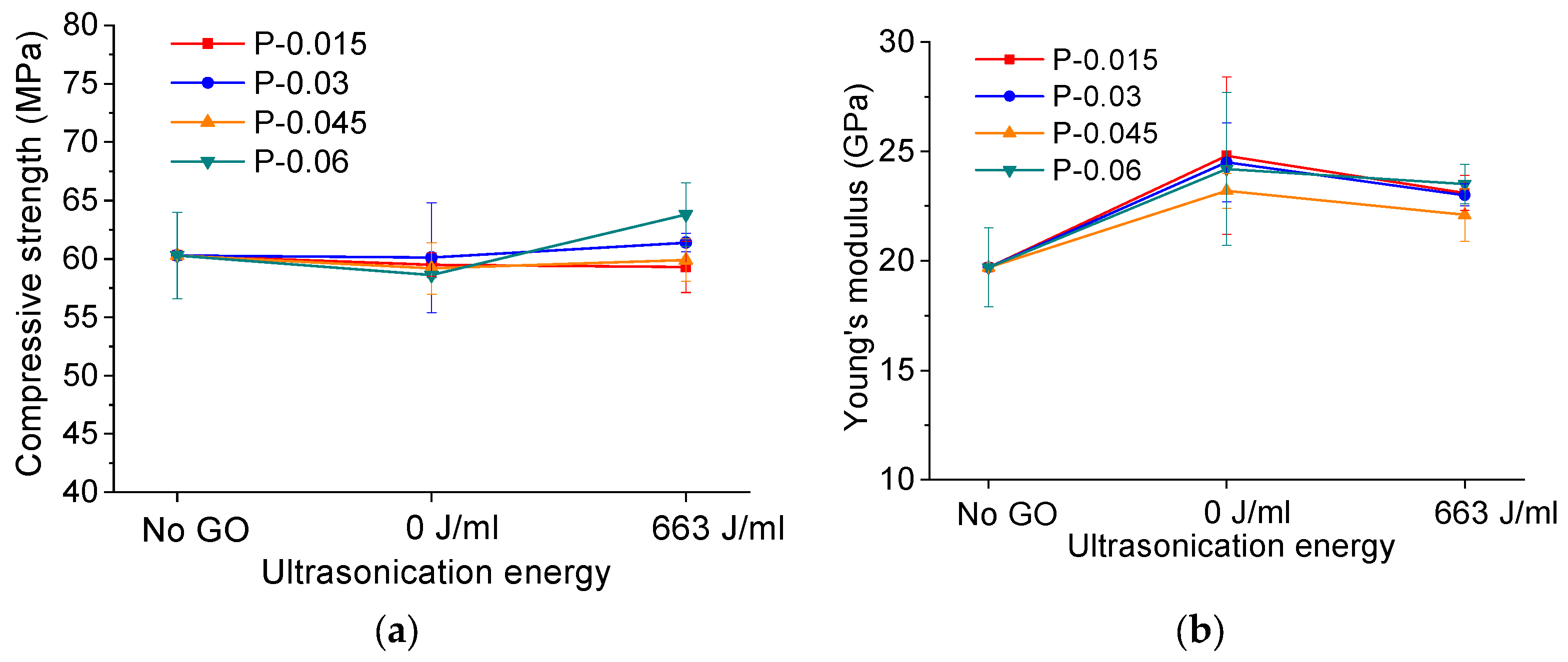
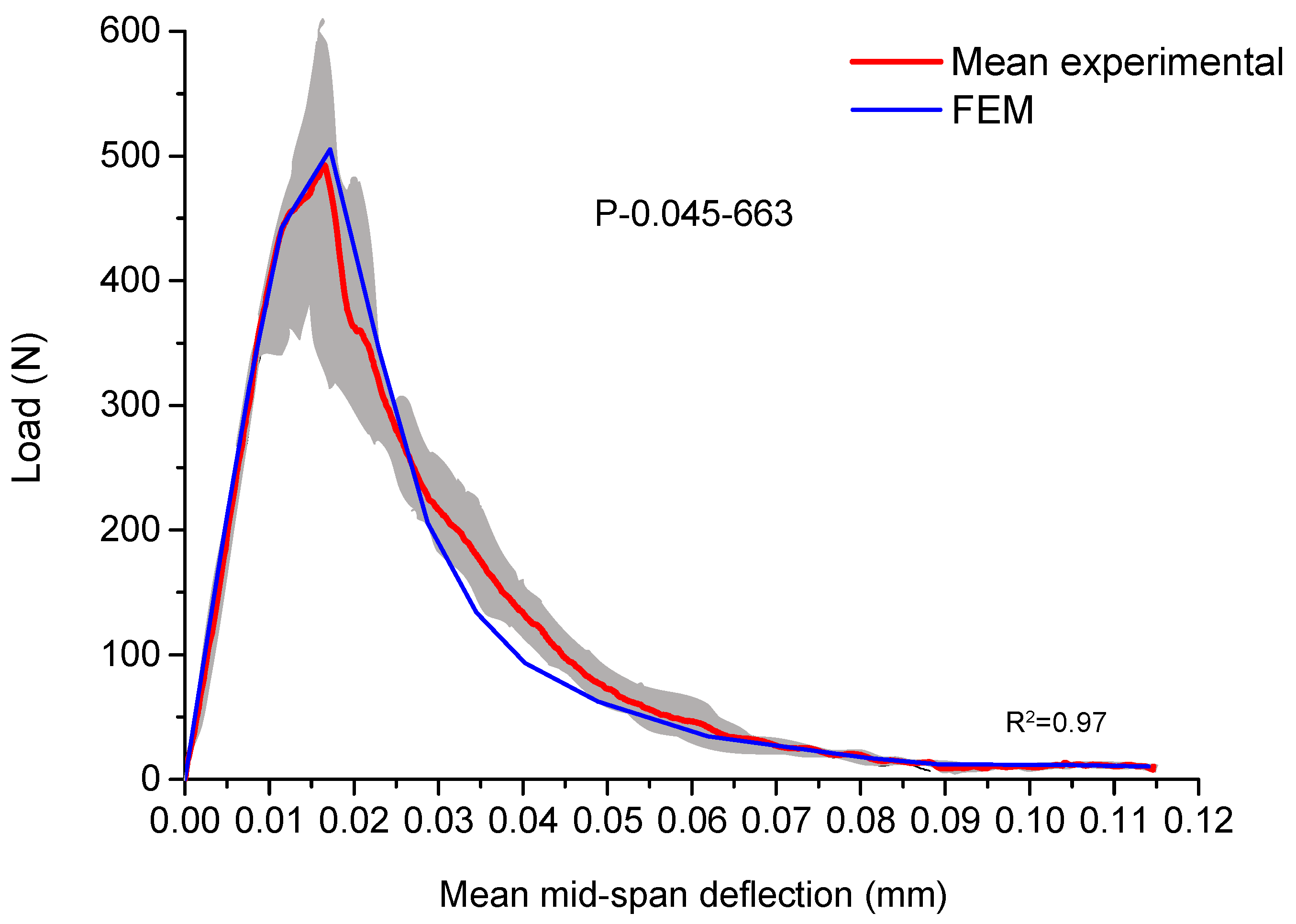

| CaO | Al2O3 | SiO2 | SO3 | Fe2O3 | K2O | MgO | Na2O | TiO2 |
| 45.61 | 6.59 | 18.29 | 4.02 | 2.85 | 1.09 | 1 | 0.29 | 0.41 |
| P2O5 | Cl2O3 | BaO | MnO2 | SrO | CuO | ZnO | LOI | Total |
| 0.13 | 0.07 | 0.06 | 0.05 | 0.05 | 0.04 | 0.02 | 19.43 | 100 |
| Time (min) | Ultrasonication Energy (J/mL) | Min. GO Sheet Size (μm) | Max. GO Sheet Size (μm) | Mean GO Sheet Size (μm) |
|---|---|---|---|---|
| 0 | 0 | 0.483 ± 14.7% | 5.90 ± 87.7% | 3.10 ± 74.4% |
| 10 | 224 | 0.255 ± 3.4% | 0.99 ± 0.3% | 0.572 ± 0.1% |
| 15 | 299 | 0.250 ± 0.0% | 0.99 ± 0.3% | 0.544 ± 0.5% |
| 30 | 663 | 0.211 ± 0.0% | 0.89 ± 0.0% | 0.465 ± 0.1% |
| 45 | 1204 | 0.199 ± 0.0% | 0.99 ± 0.3% | 0.492 ± 0.1% |
| 60 | 1518 | 0.208 ± 12.1% | 0.99 ± 0.3% | 0.491 ± 1.1% |
| 90 | 1831 | 0.203 ± 6.5% | 1.03 ± 3.4% | 0.536 ± 4.9% |
| 120 | 2582 | 0.223 ± 0.0% | 1.17 ± 6.8% | 0.639 ± 8.4% |
| Cement (kg/m3) | w/c Ratio | GO (%) | Ultrasonication Energy (J/mL) | |
|---|---|---|---|---|
| P–0–0 | 1400 | 0.35 | 0 | 0 |
| P–0.015–0 | 1400 | 0.35 | 0.015 | 0 |
| P–0.015–663 | 1400 | 0.35 | 0.015 | 663 |
| P–0.03–0 | 1400 | 0.35 | 0.03 | 0 |
| P–0.03–663 | 1400 | 0.35 | 0.03 | 663 |
| P–0.045–0 | 1400 | 0.35 | 0.045 | 0 |
| P–0.045–663 | 1400 | 0.35 | 0.045 | 663 |
| P–0.06–0 | 1400 | 0.35 | 0.06 | 0 |
| P–0.06–663 | 1400 | 0.35 | 0.06 | 663 |
| Pore Volume (mL/g) | |||
|---|---|---|---|
| <500 nm | 500–8000 nm | >8000 nm | |
| P–0–0 | 1.70 ± 0.05 | 0.076 ± 0.004 | 0.062 ± 0.004 |
| P–0.015–0 | 1.59 ± 0.04 | 0.049 ± 0.003 | 0.060 ± 0.005 |
| P–0.015–30 | 1.26 ± 0.03 | 0.044 ± 0.003 | 0.069 ± 0.004 |
| P–0.03–0 | 1.19 ± 0.04 | 0.049 ± 0.006 | 0.061 ± 0.005 |
| P–0.03–30 | 1.15 ± 0.04 | 0.041 ± 0.003 | 0.066 ± 0.005 |
| P–0.045–0 | 0.85 ± 0.01 | 0.028 ± 0.002 | 0.056 ± 0.004 |
| P–0.045–30 | 0.94 ± 0.01 | 0.022 ± 0.002 | 0.061 ± 0.004 |
| P–0.06–0 | 1.21 ± 0.02 | 0.047 ± 0.003 | 0.099 ± 0.006 |
| P–0.06–30 | 1.11 ± 0.03 | 0.045 ± 0.005 | 0.065 ± 0.005 |
| Mix | Fracture Energy, GF (N/m) |
|---|---|
| P–0–0 | 20.5 ± 3.7 |
| P–0.015–0 | 24.9 ± 1.5 |
| P–0.015–663 | 21.8 ± 1.5 |
| P–0.030–0 | 22.3 ± 2.4 |
| P–0.030–663 | 21.9 ± 1.6 |
| P–0.045–0 | 21.6 ± 2.3 |
| P–0.045–663 | 19.6 ± 1.9 |
| P–0.060–0 | 21.9 ± 4.4 |
| P–0.060–663 | 22.2 ± 2.7 |
| ft (MPa) | σ1 (MPa) | a1 (mm−1) | a2 (mm−1) | w1 (mm) | wu (mm) | Gf (N/m) | GF–Gf (N/m) | Ec (GPa) | lch (m) | |
|---|---|---|---|---|---|---|---|---|---|---|
| P–0–0 | 5.3 | 0.16 | 771.6 | 6.7 | 0.0068 | 0.030 | 17.85 | 1.8 | 19.7 | 0.015 |
| P–0.01–0 | 4.3 | 0.13 | 595.9 | 4.6 | 0.0072 | 0.035 | 15.48 | 1.8 | 24.8 | 0.033 |
| P–0.015–663 | 4.5 | 0.18 | 568.4 | 5.6 | 0.0075 | 0.040 | 16.87 | 3.8 | 23.1 | 0.025 |
| P–0.030–0 | 4.0 | 0.36 | 527.5 | 15.6 | 0.0076 | 0.030 | 15.20 | 4.0 | 24.5 | 0.034 |
| P–0.030–663 | 5.5 | 0.18 | 771.6 | 6.7 | 0.0070 | 0.030 | 19.25 | 2.2 | 23.0 | 0.017 |
| P–0.045–0 | 4.5 | 0.27 | 660.9 | 10.5 | 0.0068 | 0.032 | 15.30 | 3.4 | 22.1 | 0.024 |
| P–0.045–663 | 5.7 | 0.17 | 921.5 | 7.1 | 0.0062 | 0.030 | 17.67 | 2.0 | 21.2 | 0.013 |
| P–0.060–0 | 4.2 | 0.25 | 660.9 | 10.5 | 0.0067 | 0.032 | 14.07 | 3.2 | 24.2 | 0.030 |
| P–0.060–663 | 4.5 | 0.27 | 660.9 | 10.5 | 0.0068 | 0.032 | 15.30 | 3.4 | 23.5 | 0.026 |
Disclaimer/Publisher’s Note: The statements, opinions and data contained in all publications are solely those of the individual author(s) and contributor(s) and not of MDPI and/or the editor(s). MDPI and/or the editor(s) disclaim responsibility for any injury to people or property resulting from any ideas, methods, instructions or products referred to in the content. |
© 2024 by the authors. Licensee MDPI, Basel, Switzerland. This article is an open access article distributed under the terms and conditions of the Creative Commons Attribution (CC BY) license (https://creativecommons.org/licenses/by/4.0/).
Share and Cite
Ríos, J.D.; Leiva, C.; Martinez de la Concha, A.; Ariza, M.P.; Cifuentes, H. Influence of Graphene Oxide Concentration and Ultrasonication Energy on Fracture Behavior of Nano-Reinforced Cement Pastes. Crystals 2024, 14, 707. https://doi.org/10.3390/cryst14080707
Ríos JD, Leiva C, Martinez de la Concha A, Ariza MP, Cifuentes H. Influence of Graphene Oxide Concentration and Ultrasonication Energy on Fracture Behavior of Nano-Reinforced Cement Pastes. Crystals. 2024; 14(8):707. https://doi.org/10.3390/cryst14080707
Chicago/Turabian StyleRíos, José D., Carlos Leiva, Antonio Martinez de la Concha, María Pilar Ariza, and Héctor Cifuentes. 2024. "Influence of Graphene Oxide Concentration and Ultrasonication Energy on Fracture Behavior of Nano-Reinforced Cement Pastes" Crystals 14, no. 8: 707. https://doi.org/10.3390/cryst14080707





